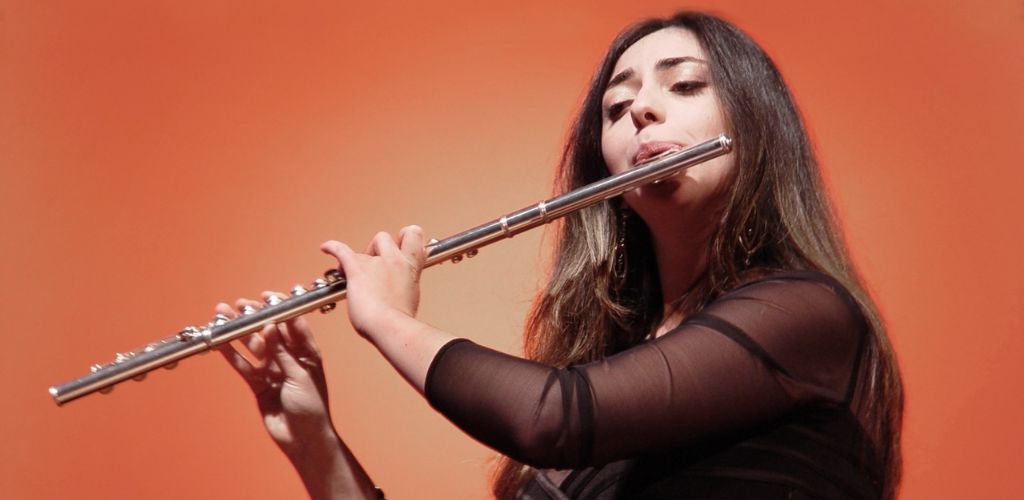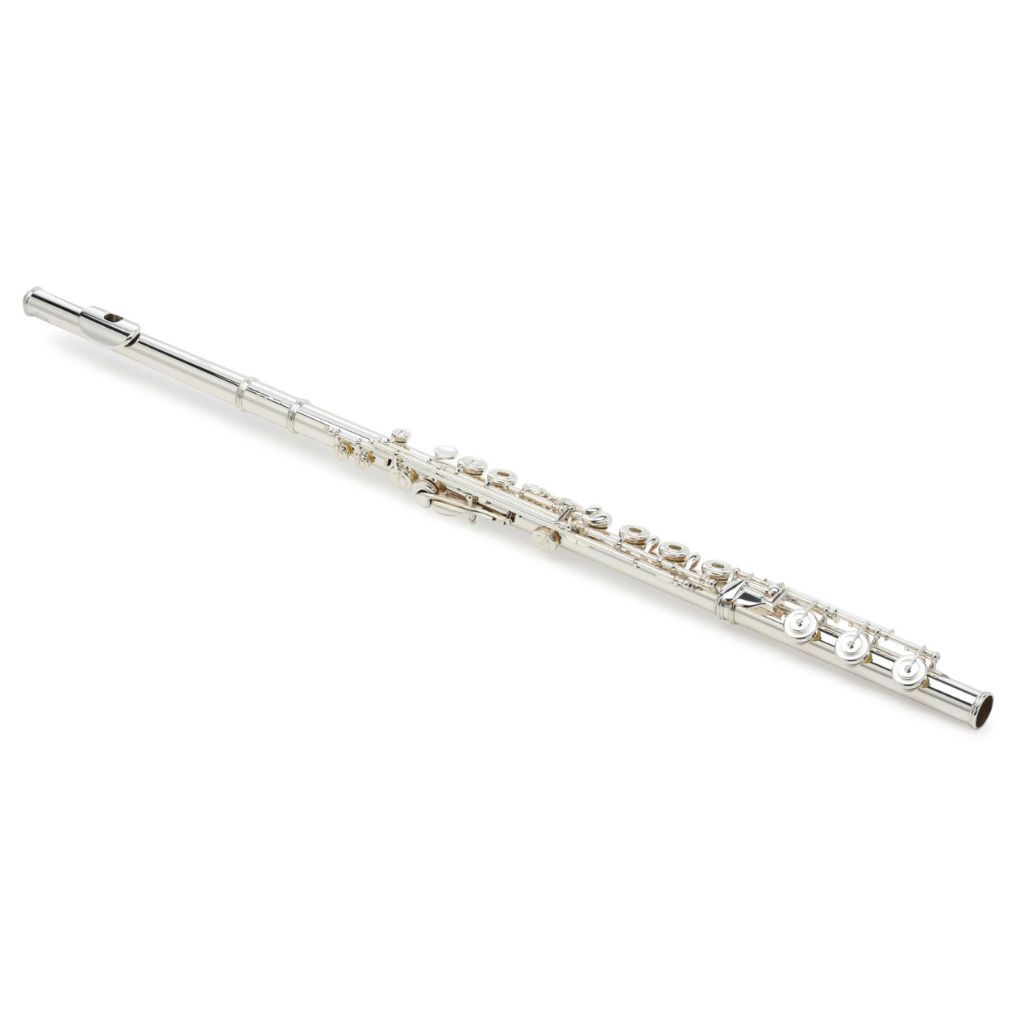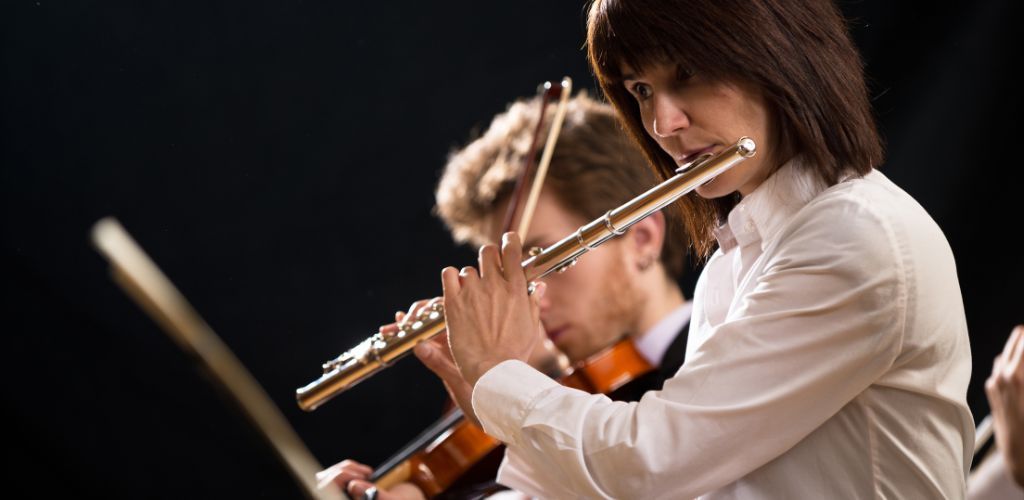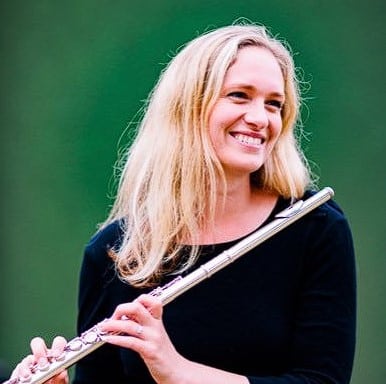Best
Beginner
Flute
YFL-222 Student Flute smooth and responsive playing experience
-
Overall: The design is based on Yamaha's Professional Series flutes.
-
Best Feature: Nickel silver construction provides increased durability and a rich tone.
-
TedScore™: 9/10
Best
High-end
Flute
-
Overall: Custom-crafted professional concert flute with luxurious features.
-
Best Feature: Coin silver N-cut head joint delivers a broad, stable tone and remarkable playability.
-
TedScore™: 10/10
Best
Intermediate
Flute
505RBE1RB Quantz Series
Intermediate Flute a choice that
won't disappoint
-
Overall: Traditional craftsmanship combined
with modern innovation. -
Best Feature: Silver-plated head joint, body, and foot joint.
-
TedScore™: 9/10
If you’ve ever struggled with getting a good sound from the flute and wondered how to fix flute embouchure, you’re not alone! When I first tried to play the flute, I felt like I was blowing air into it with no success.
I discovered that the secret lies in the magic of adjusting your embouchure – that’s how you shape your mouth and use your lips when playing. It’s the golden ticket to a clear, beautiful tone.

Want to learn how to improve your flute playing with easy embouchure changes? Prepare for a fun journey into flute mastery that will captivate your listeners.
Keep reading, and we’ll discover some neat tricks that will have your flute making beautiful music in no time!
Developing a
Proper Embouchure
Crafting the perfect embouchure is like baking a delicious cake; it requires patience and the right technique.
Let’s go through the process and create a sound that’s as delightful as a freshly baked scone.
Starting with the Head joint
To kick things off, I make sure I’m only working with the head joint. It’s a first date with the flute; we need to get comfortable with each other.
Placing the head joint against my chin, I check in a mirror to ensure it’s lined up just right—like adjusting a bow tie before a big event.
Positioning the Lip Plate
Next on my agenda is the lip plate, that cozy spot where my flute meets my lips. I carefully position it so it snuggles up against the edge of my lower lip.
Not too high, not too low—finding the Goldilocks zone is essential for a stellar sound.
Embouchure Flexibility and Exercises
Flexibility is my best mate when it comes to embouchure.
To keep things sprightly, I practice blowing across the hole of the head joint, imagining I’m lightly blowing out a candle. With exercises like these, I aim for a sound that’s as clear and as sparkling as a crystal chandelier.
My embouchure begins to shape nicely through dedicated practice, using my trusty mirror, and embracing a flexible approach. Like a skilled gardener pruning a rose bush, it takes time and care to coax the best sound.

Breathing and
Air Management

Fixing flute embouchure begins with mastering breathing and air management. That’s where the magic happens—achieving that pure, mesmerizing sound we all adore.
Maintaining a Steady Air Stream
Maintaining a steady stream of air is essential for a consistent tone. I always envision drawing a long, steadfast line in the air with my breath, ensuring it never wavers.
A steady air stream avoids unwanted fluctuations in pitch and volume. It’s the steadfast foundation that every note builds upon.
Controlling Air Speed and Pressure
Controlling air speed and pressure means being the maestro of your breath. I like to vary airspeed to express different tones, sometimes whispering a sweet melody or declaring a bold statement.
Cranking up the air pressure allows me to hit higher pitches without strain. Conversely, easing pressure can create a soft, lush lower tone.
Producing a Clear Tone
To create the clearest tone, I focus on the shape of my mouth and the so-called ‘pooh’ sound—that gentle, rounded beginning that fires a perfectly formed column of air. It’s all about channeling the breath precisely.
I ensure my teardrop-shaped upper lip doesn’t obstruct the air exit, letting the air flow freely, like water from a fountain. This pristine airstream carves out the ideal sound from my flute, pure and true.
Understanding
the Flute Embouchure
I always find it fascinating how a player’s lips shape the essence of the music flowing from a flute. It’s a subtle art, creating just the correct aperture with your lips to craft the perfect tone.
Embouchure Basics
Good flute embouchure is crucial for producing a clear and resonant tone.
Embouchure refers to how I position and use my lips on the mouthpiece of a flute. It’s the magical doorway through which air transforms into music. An effective embouchure allows me to control the flute’s tone, pitch, and even the dynamic expression of the notes.

The lips are an adjustable valve that modulates the airspeed and direction entering the embouchure hole. I can significantly influence sound quality by fine-tuning the shape and size of the aperture formed by the lips.
A smiling embouchure is often recommended, where the corners of the mouth are slightly raised, creating the ideal shape for directing the air across the blow hole. When playing the flute, the embouchure involves just the head, with the upper and lower lip forming a firm yet flexible seal around the mouthpiece to control airflow and produce a beautiful sound.
Role of the Lips in Flute Playing

Flexible flute embouchure is essential for beginning flute players as it allows them to adapt and develop their tone production skills as they progress in their musical journey.
My lips are the primary tools for steering the airstream into the flute. The upper lip usually remains relatively steady, while the lower lip can stretch or contract. This action directly alters the character of the notes I play.
The thickness and firmness of my lips also come into play. If the lips are too tense, it can inadvertently create a strained, thin sound. I aim for a relaxed yet controlled formation, allowing flexibility to sustain an even, rich tone throughout the performance.
Shape and Size of the Aperture

The shape of the aperture formed by my lips tends to be oval. Imagine whistling a soft tune; that’s roughly the shape we’re aiming for. This small opening becomes the exiting point for the airstream, shaping the flute’s voice.
The size of the aperture is equally essential and varies depending on the pitch and volume I aim to produce. A smaller aperture usually works best for higher notes, while lower notes may require a slightly larger one.
There’s a delicate balance in maintaining an opening that’s just right — not too windblown and certainly not too stingy.
Top Flute Brands
Yamaha

My first flute was a Yamaha; honestly, it was love at first note. Yamaha flutes are widely respected for their consistent quality and are often the go-to choice for novice players.
Their student models, such as the YFL-222, offer a smooth and responsive playing experience with an offset G key perfect for smaller hands.
Yamaha YFL-222 Student Flute with Offset G Key System

DESIGNED FOR: Beginners
FEATURES: The design is based on Yamaha's Professional Series flutes.
OTHER INFO: Nickel silver construction provides increased durability and a rich tone.
Yamaha YFL-222 Student Flute with Offset G Key System
- Hand-assembled silver-plated keys.
- Comfortable offset G key system.
- Includes case.
- While some players find the offset G key comfortable, others may prefer an inline G key system, so it's a matter of personal preference.
When you click ‘Check Price’, you’ll see there are loads of great places to buy this item. Our personal favorite is Sweetwater for the US, and Thomann and Gear4Music for the UK & Europe.
They are the largest music retailers, with excellent customer service, competitive prices, really fast shipping, and the longest guarantees.
The professional musician who wrote this article combined many things,
from the product build, manufacturer’s reputation through to feedback
from other users, to create our famous TedScore™.
Pearl
Pearl flutes are like reliable friends you can always count on. Their charm combines durability with a stunning tone, making them a top pick for intermediate flutists.
My experiences with the Pearl 505RBE1RB Quantz Series flute tell me it’s a choice that won’t disappoint, with features like pinless mechanisms and French pointed arms.
Pearl Flutes 505RBE1RB Intermediate Flute

FEATURES: Traditional craftsmanship combined with modern innovation.
OTHER INFO: Silver-plated head joint, body, and foot joint.
- Hand-assembled silver-plated keys are effortless to play.
- Comfortable offset G key system with French-style open keys and split E mechanism.
- It Includes a French case with a cover, cleaning cloth, cleaning rod, and polishing cloth.
- It may offer limited customization options compared to other intermediate flutes.
When you click ‘Check Price’, you’ll see there are loads of great places to buy this item. Our personal favorite is Sweetwater for the US, and Thomann and Gear4Music for the UK & Europe.
They are the largest music retailers, with excellent customer service, competitive prices, really fast shipping, and the longest guarantees.
The professional musician who wrote this article combined many things,
from the product build, manufacturer’s reputation through to feedback
from other users, to create our famous TedScore™.
Wm. S. Haynes

Wm. S. Haynes flutes shine with their artistically sculpted tone in the hands of discerning flutists.
It’s known that Wm. S. Haynes utilizes 18K Gold Riser, and their flutes offer a beautiful spectrum of colors in their sound owing to this craftsmanship.
Wm. S. Haynes Custom Silver Flute

FEATURES: Custom-crafted professional concert flute with luxurious features.
OTHER INFO: Coin silver N-cut head joint delivers a broad, stable tone and remarkable playability.
- High-quality 10k white gold springs deliver top-notch responsiveness.
- Pisoni S2 pads provide an airtight seal.
- B foot joint extends the low range of the instrument.
- 18k gold riser adds to the flute's already exquisite tone quality.
- Includes case for safe storage and transport.
- Handmade in Acton, Mass.
- Higher price point.
When you click ‘Check Price’, you’ll see there are loads of great places to buy this item. Our personal favorite is Sweetwater for the US, and Thomann and Gear4Music for the UK & Europe.
They are the largest music retailers, with excellent customer service, competitive prices, really fast shipping, and the longest guarantees.
The professional musician who wrote this article combined many things,
from the product build, manufacturer’s reputation through to feedback
from other users, to create our famous TedScore™.
How to fix flute embouchure:
Final Recap
Improving your flute embouchure can seem like a jolly puzzle, but it’s rewarding once the pieces fit. A dash of patience mixed with consistent practice can lead to marvelous advancements.
Remember to check your hand position—it could be the secret ingredient you’ve been missing. And who’d have thought a mirror could become your best mate? It offers honest feedback to see if your flute parallels your lips.

Your smile is lovely but keep it away from your embouchure to avoid pitch and tone capers. Instead, keep the corners of your lips firm while letting your bottom lip be comfy and relaxed over the embouchure hole.
Keep an eye out for that pouty face—it’s not just for ducks and selfies; it helps direct your air just right.
Lastly, stay flexible and remember to let those lips and jaw dance a little, adjusting the air’s angle and shape. Give that embouchure flexibility exercise a whirl; it’s pretty amusing and will have you puffing air like an ace before tea time.
I’ve thoroughly enjoyed sharing these tips, and they’ll help you create a sound as rich and delightful as a spot of afternoon tea. Happy fluting!
Hold on…
Explore whether the Yamaha flute offers good value for its price in this informative article that delves into its features and suitability for beginner players.
FAQ's
To improve your flute embouchure, focus on forming a small, firm aperture with your lips and directing the air downward across the blow hole. Practicing long tones and scales while paying attention to your embouchure will help you develop a more controlled and resonant flute sound.
A flute embouchure should form a small, oval-shaped opening with the lips, directing the airstream across the blow hole at a downward angle to produce a clear and best tone.
To achieve the perfect embouchure, focus on forming a small, firm aperture with your lips and directing the air across the blow hole in a downward direction.
While playing the flute, maintain a relaxed lip position, creating a small, firm aperture to guide the air across the blow hole. Ensure that the corners of your mouth remain firm while keeping the center relaxed to enable smooth airflow and produce a clear, resonant tone.










